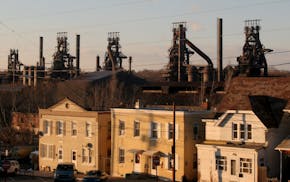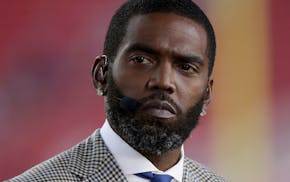CHICAGO — Democrats had just absorbed a crushing defeat in the 1994 midterm elections when President Bill Clinton's very liberal labor secretary, Robert Reich, ventured into hostile territory to issue a prophetic warning.
Struggling workers were becoming "an anxious class," he said. Society was separating into two tiers, with "a few winners and a larger group of Americans left behind, whose anger and whose disillusionment is easily manipulated."
"Today, the targets of that rage are immigrants and welfare mothers and government officials and gays and an ill-defined counterculture," Reich cautioned. "But as the middle class continues to erode, who will be the targets tomorrow?"
His message went largely unheeded for 30 years, as one president after another, Republican and Democratic, led administrations into a post-Cold War global future that enriched the nation as a whole and some on the coasts to staggering levels but left many pockets of the American heartland deindustrialized, dislocated and even depopulated.
As a half-century-old world order organized around U.S.-Soviet contention gave way to a more freely competitive landscape of shifting alliances, presidents from both parties sought to secure U.S. leadership under new rules for economic competition, global stability and strong financial markets. Democratic presidents tried, with limited success, to expand safety nets at home, especially health care and income support for the poor. In the end, however, their bets on foreign policy took precedence, and a new fealty to megadonors shaped fiscal policies that bolstered financial markets but shuttered many factories.
The unintended consequences often came at the expense of American workers. And Reich's "anxious class" felt unheard until the rise of an unlikely new kind of Republican: Donald Trump.
The Democratic Party's estrangement from working-class voters first became clear with Trump's upset of Hillary Clinton in 2016, powered by broad shifts in the preferences of white voters without college degrees, and it became even more unmistakable with his defeat of Vice President Kamala Harris in November. That result was a reckoning for a party that thought it had fixed its problems with blue-collar voters by heavily reinvesting in domestic manufacturing but instead discovered even more erosion, this time among Black and Latino workers.
Many Democrats have blamed recent social issues like transgender rights. But the economic seeds of Trump's victories were sown long ago.
"One of the things that has been frustrating about the narrative 'The Democrats are losing the working class' is that people are noticing it half a century after it happened," said Michael Podhorzer, the former political director of the AFL-CIO. "The resentment and movement away from the Democrats began long before they were for nongendered bathrooms. It was because their lives were becoming more precarious, their kids were leaving town, the pensions they expected were evaporating, and that took a toll."
To be sure, blue-collar voters have long been fickle. Richard M. Nixon's "silent majority" delivered him a landslide in 1972, propelled not by a Republican economic platform but by a backlash to civil rights legislation and anti-Vietnam War protests. The so-called Reagan Democrats, stung by inflation and economic malaise, helped give the White House back to the GOP eight years later, and it remained in Republican hands for 12 long years.
William A. Galston, a domestic policy adviser to Bill Clinton and an architect of the Democrats' shift to the center, said after the election debacles of 1980, 1984 and 1988, the party's repositioning on social and economic issues was not a choice but an imperative.
But once Clinton took office in 1993, choices were made.
The North American Free Trade Agreement had been negotiated under President George H.W. Bush. It fell to Clinton to get it through Congress. His rationale was that the trade agreement would enhance Mexico's stability and economic growth, reduce illegal immigration and foster cooperation in fighting drug trafficking. A wider social safety net — including universal health care, expanded education and job training and economic investment — would cushion the blow of employment losses, while cheaper consumer goods would make everyone happy.
Then the health care push collapsed in the late summer of 1994. Republicans took control of Congress after decisive victories that November, and the domestic agenda was moribund, replaced by a zeal for budget cutting. The Clinton administration faced a choice: Pull the plug on free trade and internationalism or push ahead without the safety-net side.
Over the objections of more liberal voices in the administration, Clinton chose the latter, pressing on with legislation to normalize trade relations with China and allow Beijing to join the World Trade Organization.
Even then, there was concern China's accession into the family of trading nations could flood the United States with cheap imports and bankrupt U.S. manufacturers. But the economy was roaring; deregulation was the order of the day as the administration worked to free Wall Street from Depression-era banking and investment rules; and, most importantly, a reformer, Jiang Zemin, had taken control in China. The foreign policy chiefs in the White House believed firmly that cooperation was vital to securing a prosperous, peaceful and eventually democratic China.
That tendency to roll the dice on grand international bets, with working-class voters as the chips, would become a theme. Too often, the bets did not pay off.
China became more autocratic, not less. And the feared tsunami of Chinese exports indeed arrived, along with the damage. In 1998, 17.6 million Americans were employed in manufacturing. By January 2008, the "China shock" had cost U.S. manufacturers nearly 4 million jobs. By January 2010, as the financial crisis waned, manufacturing employment had bottomed out below 11.5 million.
Still, China's integration into world markets did increase the number of jobs in the United States — selling services like insurance and Hollywood movies to the Chinese, and peddling Chinese-made goods at stores like Walmart — while lowering the cost of living for American consumers.
What was less appreciated beforehand was the psychological damage that would be done by factory closures in communities where prestige, stability and identity centered on those plants — as well as the political impacts of those closures on key industrial states.
Democratic policies focused on people as consumers instead of as workers, counting on those people whose jobs were eliminated to find their way to jobs newly created — an assumption that was often flawed, given that the new service jobs frequently required out-of-reach skills or were located on the coasts, not in the upper Midwest.
The Democrats' alienation from blue-collar voters was scarcely a unique phenomenon. Across the developed world, as Western democracies have grown more affluent and less industrially centered, so have the parties that once represented the working classes, said Thomas Piketty, a French economist who has become one of the foremost experts on wealth inequality.
It seemed to make sense politically: With the largest cities and the growing suburbs backing those center-left parties — which Piketty called the "parties of the educated" — shrinking towns and rural areas would matter less and less.
But there was always a problem with the theory, because about 60% of the workforce is not college-educated.
Douglas Holtz-Eakin, a veteran Republican economic adviser in the George W. Bush White House and for John McCain's 2008 presidential campaign, observed that huge shocks to the nation's economic system — terrorism and war, the financial crisis and the coronavirus pandemic — had upended many Americans' lives, but least of all those of the wealthy. The rich did not send their children to war, their banks were bailed out, and they rode out the pandemic working from home.
"In all of it, the elites got away unscathed," Holtz-Eakin said, "while the ordinary man took it on the chin."
Exploiting such resentments, Trump broke the Democratic formula by winning over not only a large majority of the white working class but also a strong percentage of workers of color.
If any Democrat intuitively understood the voters who were abandoning his party, it was President Joe Biden, who campaigned in 2020 as "Scranton Joe," the product of a small, deindustrialized city that epitomized the ground lost by the working class.
His victory may have been fueled by the pandemic, but his focus was on economics. He tried to undo or reverse some of the damage done by his predecessors.
His chief at the Federal Trade Commission, Lina Khan, zealously tried to break up monopoly industries. The United States Trade Representative avoided pursuing new trade deals that might rankle labor leaders, instead focusing on issues like strengthening labor rights in Mexico.
The new administration ushered out the belief that healthy financial markets, low unemployment and adequate support for people with the lowest income were enough to sustain an economic growth whose benefits would be shared broadly.
The Biden administration also moved to bolster the clout of unions, drive down unemployment so workers would gain bargaining power, and strengthen the IRS to go after affluent tax cheats.
Biden guided private investment through regulations and huge tax credits secured through Congress as well.
"A trillion dollars of private investments have already been announced and are underway," said Lael Brainard, the director of the Biden National Economic Council. "That's a pretty remarkable number. Factory construction has doubled relative to the Trump administration — doubled."
If all of that was a corrective for policies past, though, the working class proved to be in an unforgiving mood in November, when 56% of voters without college degrees voted for Trump.
Republican and Democratic economists point to a single reason: inflation. Reich's "anxious class" was as anxious as ever, unwilling to see policy shifts that might take years to bear fruit as a salve for the immediate pain of rising prices.
This article originally appeared in The New York Times.

How the Democrats lost the working class

Are nonalcoholic beverages good for you?

What a large study-of-studies found out about the possible tie between microplastics and cancer

